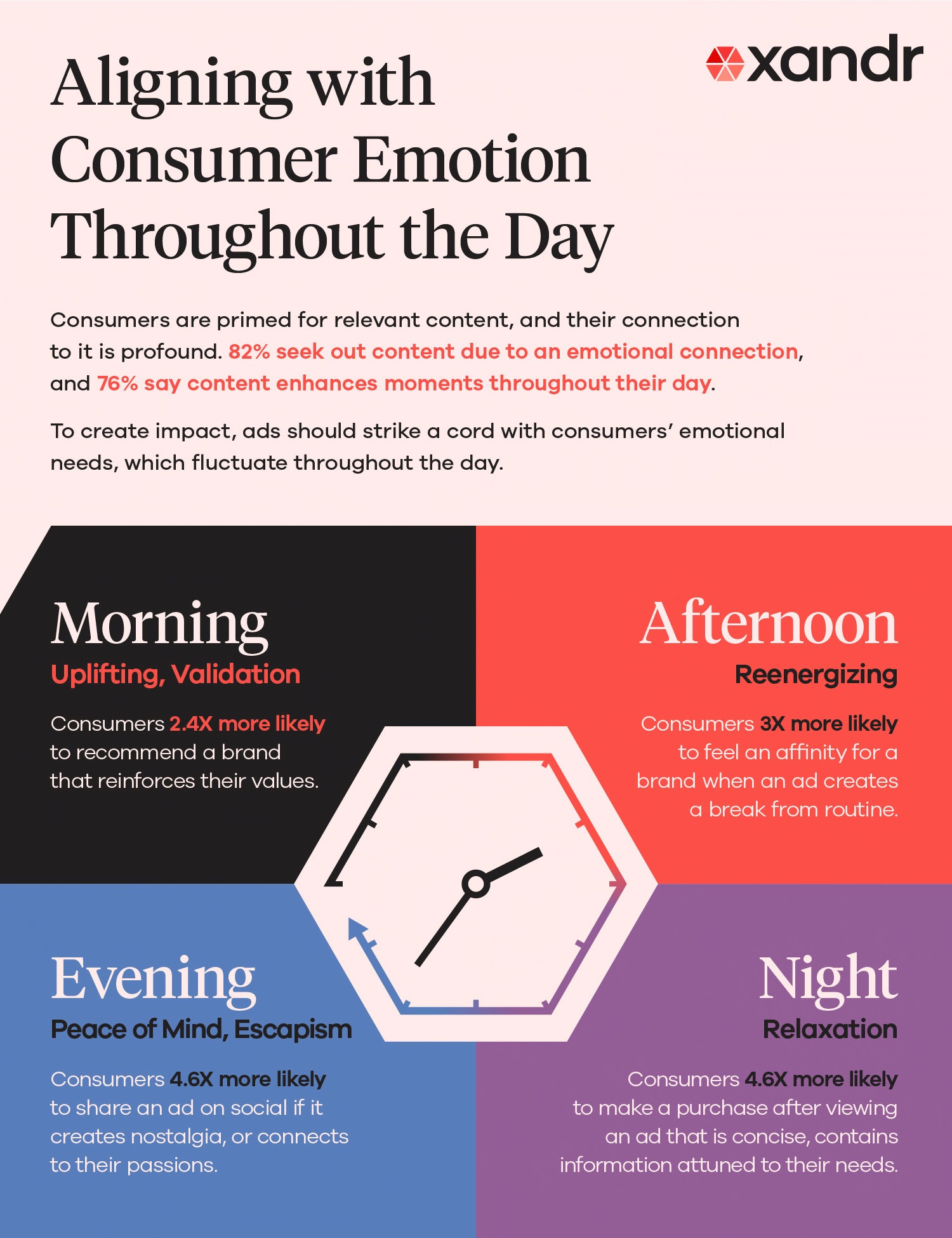Save 50% on a 3-month Digiday+ membership. Ends Dec 5.
Breaking through the noise: When consumers are most receptive to content

Jill Siegel, Director of Research, Xandr
With more content available than ever before, consumers are inundated with choices for how they spend their free time. But this unlimited content presents a challenge for marketers: consumer attention is now fractured across different sites, apps and platforms.
Xandr, AT&T’s advertising company, went straight to the source to find out how and why consumers engage with content.
Xandr conducted a survey of 3,022 consumers nationwide to understand how advertisers can better capture consumers’ attention, in addition to conducting ethnographic studies across urban and rural geographies. We found that time and attention are the ultimate currency for a consumer: when and where they spend their free time is constantly up for grabs. Between work and responsibilities at home, free time is cherished, and 68 percent of consumers we surveyed said they spend most of their free time engaging with content, with 81 percent of this daily content consumption happening on their smartphone.
When they do have free time, consumers use content to inspire positive shifts in mood. These shifts can be fueled by unexpected and differentiated content and experiences. They most often look to go from being bored, tired and stressed to motivated and happier, with 82 percent of our respondents saying that they seek content that makes them feel something.
Our goals were to uncover what types of media, both content and advertisements, command consumers’ attention at different points throughout the day. We wanted to obtain actionable insights around an advertising experience: How do advertisers craft the optimal ad experience to fuel consumer engagement? Are certain types of ads naturally better positioned for certain attention contexts? Marketers can tap into certain patterns of inherent needs and optimize what advertising consumers may react to as they go about their day.
Morning
In the morning, consumers are looking for their content to inform them and give them energy and motivation to start their day. Content is what excites them to start their day, and after engaging, their happiness and motivation increases by 11 percentage points. Consumers only have 30 minutes or less to engage with content, so they want practical information that is both supportive and streamlined. During this time, they generally use their smartphones to catch up on their newsfeeds, both traditional and social.
Afternoon
During the afternoon consumers are looking for information that is presented in a fun way, so it feels like a break from their routine. Generally, they check out social media sites, print media and free streaming sites at this time. On average, consumers only have 15 minutes to an hour to enjoy content in the afternoon and they want ads that give them updates and information. During the afternoon, 65 percent of consumers use their smartphones, followed by 56 percent who use their personal and laptop computers.
Evening
In the evening, consumers are looking for content to help them connect with others. They want material that is visually pleasing to help them relax after their day. After engaging with content in the evening, consumers relaxation increases by six percentage points. This is the time when they have the most time for content, 1-4 hours, and when they spend time with family members, relaxing or eating dinner. Their main device in the evening is TV: 64 percent said they used TV often at this time and TV usage is 11 percentage points higher during the evening than at other times of the day.
Nighttime
At nighttime, consumers are looking to relax and recharge through content. They generally have about 30 minutes to three hours for content, and they want short ads and materials which highlight how a product can help a personal need, not simply interrupt their viewing experience. Their main device is a smartphone — 64 percent — closely followed by TV at 60 percent. During this time, consumers most likely are checking out subscription streaming services, social media sites and having some “me-time.”
To break through the noise and capture consumer attention, brands and publishers must be committed to offering better media, content and advertising experience, which aligns to consumers’ fluctuating interests and emotions.
Data and technology are critical to serving relevant content to consumers at the right times, in the right channels and in the correct context, but meeting a consumer’s needs — and matching their interests — can’t be an afterthought.

__________________
Xandr 2018 Relevance Report; 3,022 Respondents; Vendor – Insight Strategy Group.
More from Digiday

In Graphic Detail: CMOs at a crossroads of power and proof
CMOs are closing out another year defined by churn and shifting ground.

AI-powered professional learning and the battle vs. ‘workslop’: Inside Deloitte’s Scout
Deloitte last month launched Scout as part of its Project 120, the company’s $1.4 billion investment in professional development.

As Black Friday nears, fake apologies from brands are all over Instagram
Brands have taken to social media in advance of Bliack Friday to ask followers for forgiveness. The catch: They’re apologizing for their products being too good.





